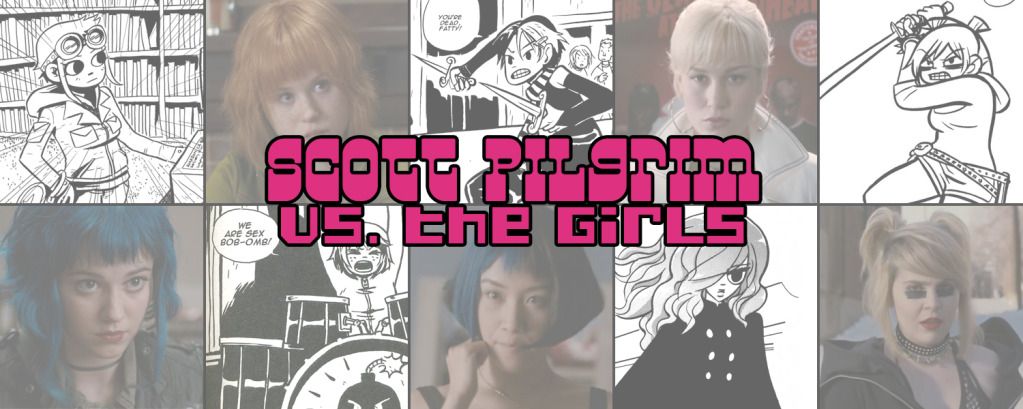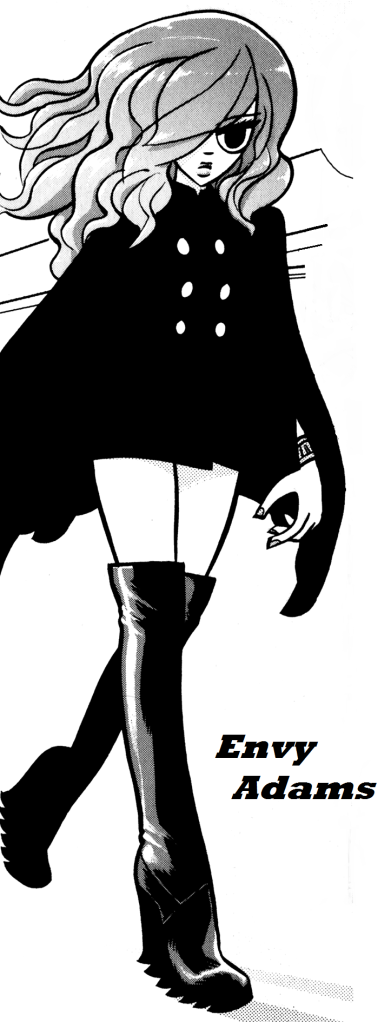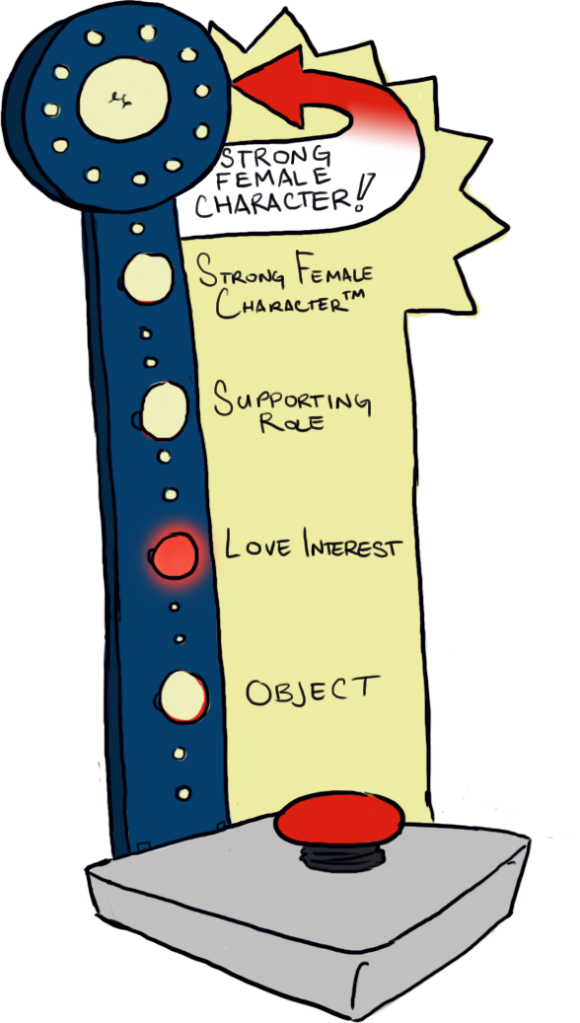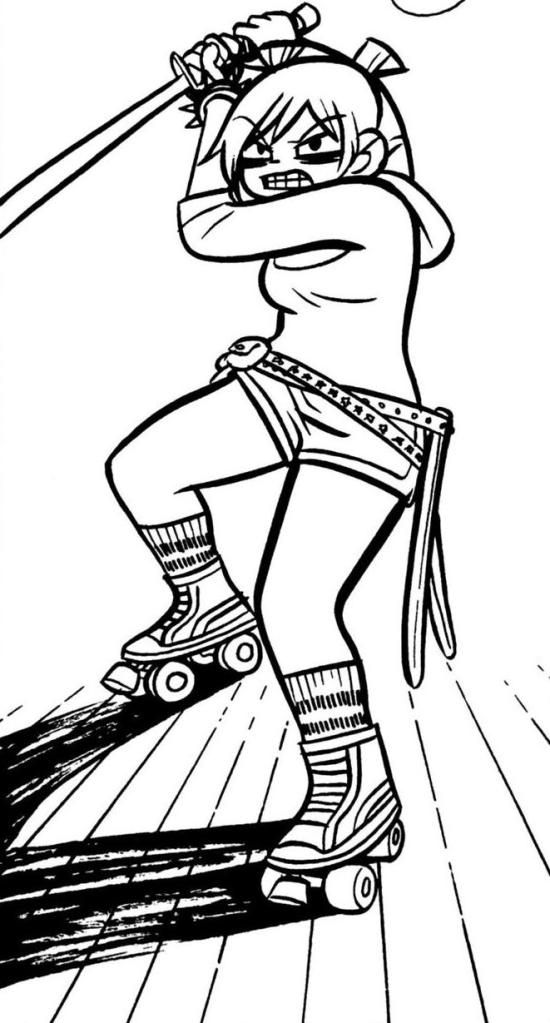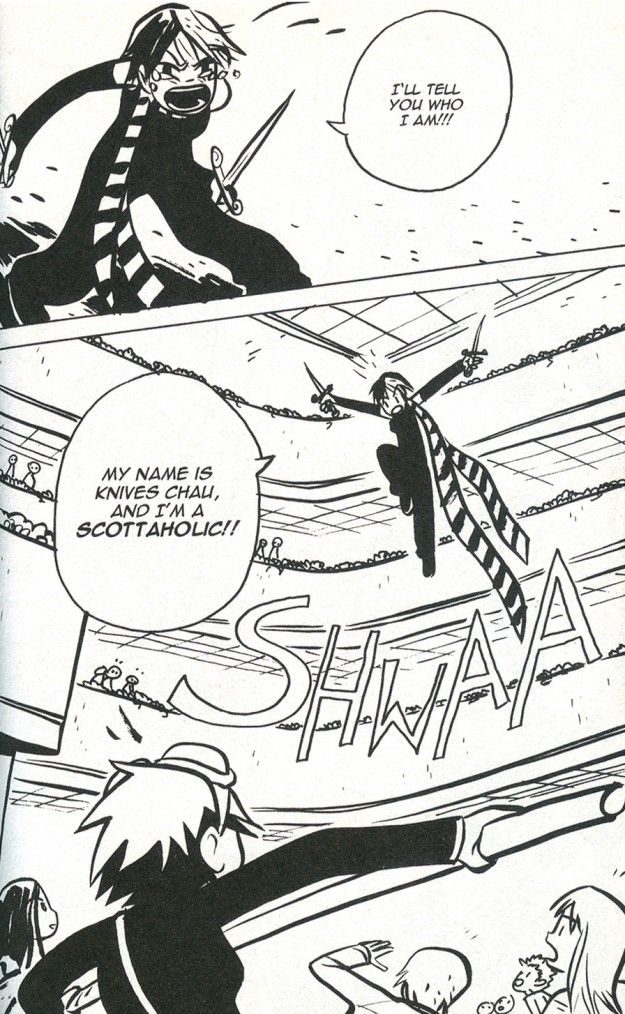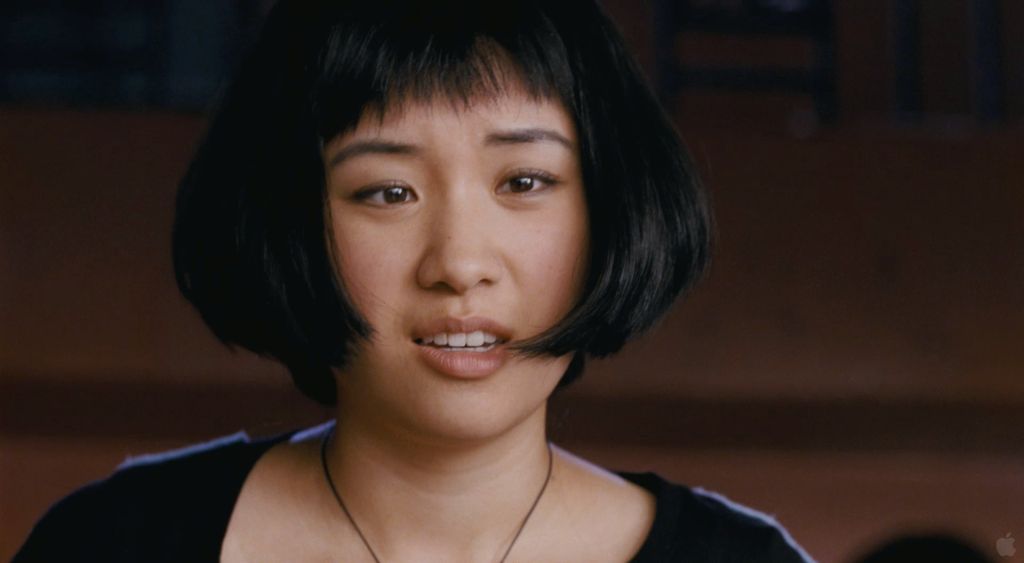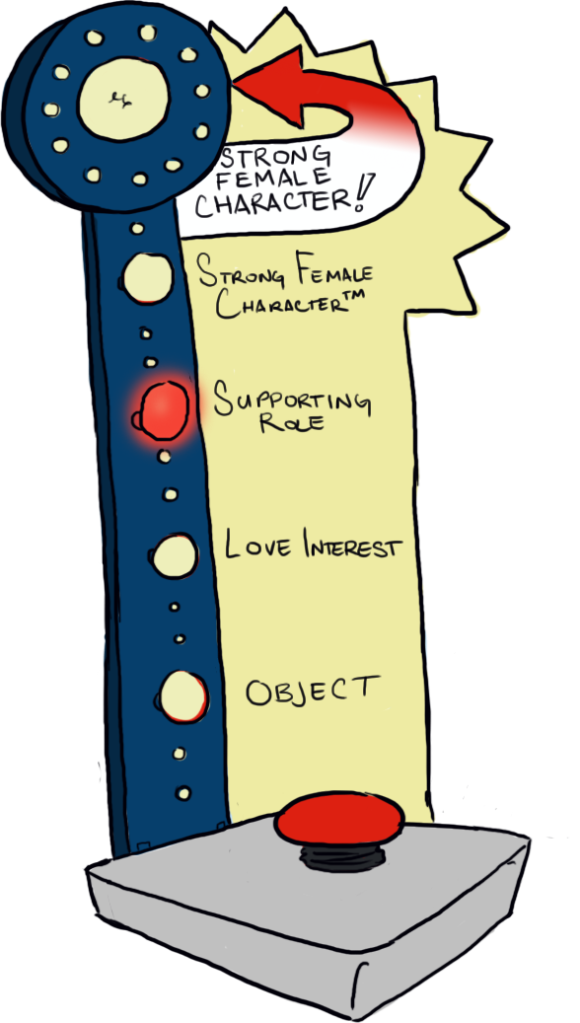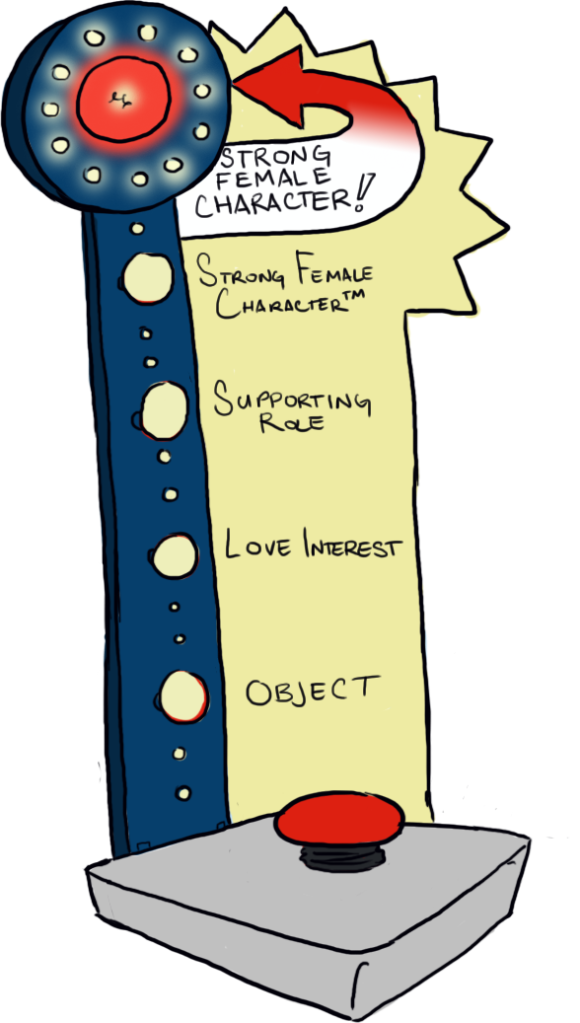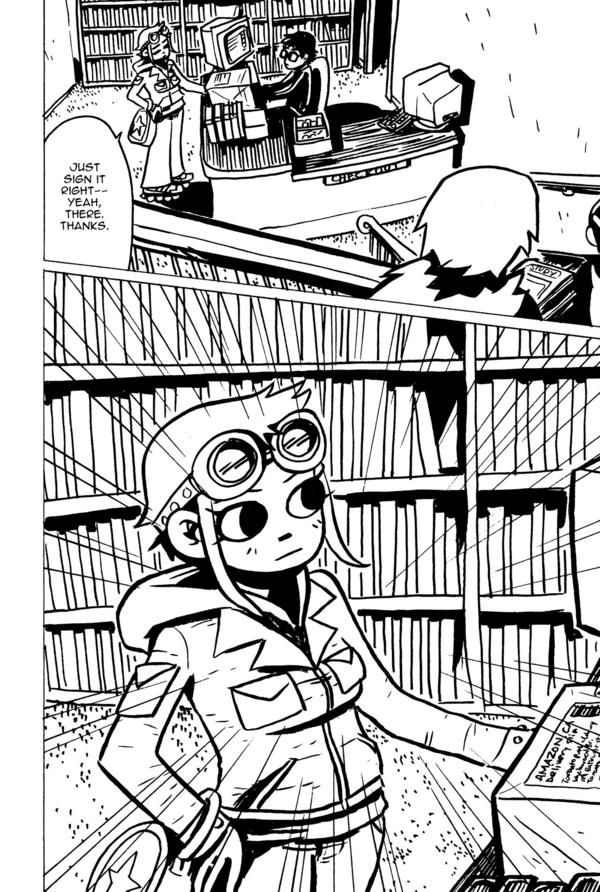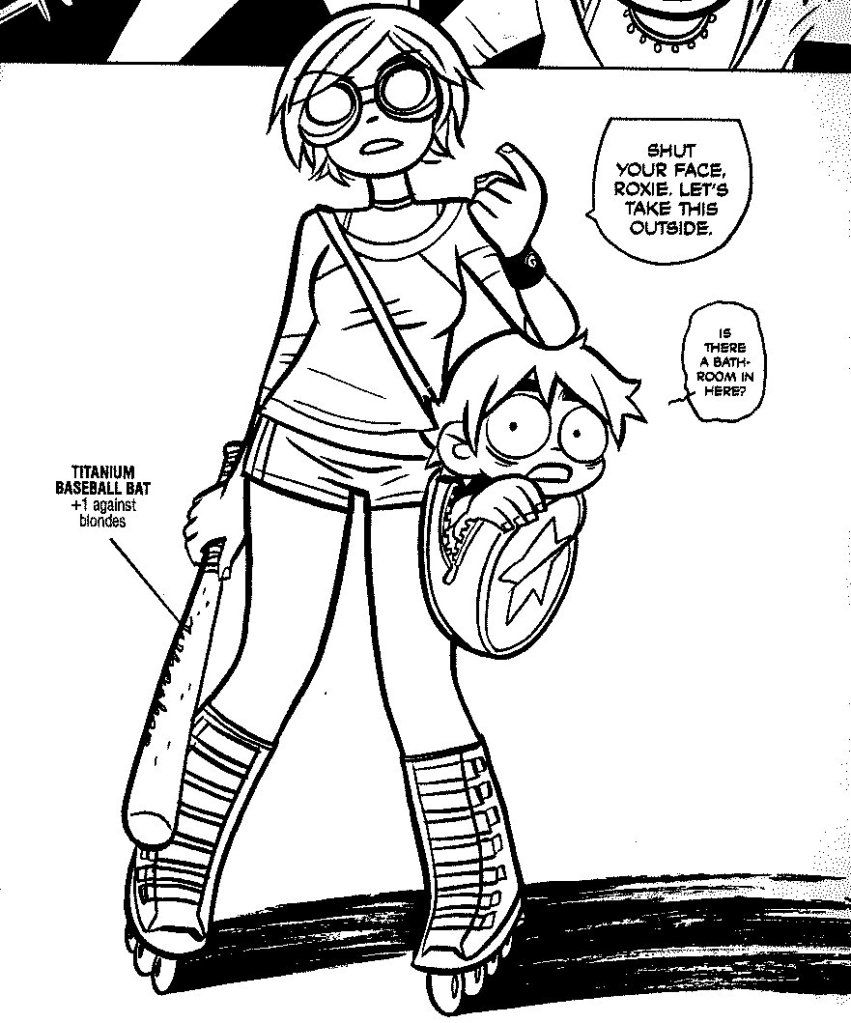 |
| George Perez |
Dear readers,
We just want to remind you that March is Reader Appreciation Month, an opportunity for us to say thank you and for you to give us your opinion about the characters you love. While we welcome you to sit back and enjoy the posts, we need your help to make this happen. If you want to request a character for us to analyze, leave a comment on this post. If you want to write a paragraph or two telling us about your favourite female comic book character, send us an email. We'll post your messages during the weekend of the Emerald City Comicon (March 1-3). This blog could do with some more voices; make yours heard!
Sincerely,
The Management
In
a series that unfolds like a video game, we would be remiss if we
didn’t discuss the boss battles. By this, of course, we mean the evil
exes.
Envy Adams
If you ask Wallace Wells, Envy Adams is pure evil. If you ask Scott Pilgrim, she is a heartbreaker. No one really asks her who she is.In
Natalie V. “Envy” Adams, Bryan Lee O’Malley traces the rise of a
superstar and the fall of a fairly decent human being. When we meet
Natalie in a flashback, she is an anime fangirl who wears baggy hoodies
and dislikes parties. Over the course of her relationship with Scott,
she gives up her fannish obsessions, selling her prized possessions for
clothing and accessories; changes her name; stops remembering
relationship milestones; doesn’t bother hiding her probable cheating;
and makes all the decisions for the band they started with Stephen
Stills, even forcing Scott to switch instruments. Hers is a classic
transformation for the sake of money, fame, and power.Well,
money, fame, power, and a guy. Envy appears to be yet another example
of what can go wrong when a woman builds her life around a man. She is
completely devoted to Todd, and this makes her blind to his flaws and
his transparent lies. She believes that his gesture of love -- punching a
hole in the moon -- demonstrates an equal devotion. She believes that
gelato is vegan, because Todd says so. Even after she has discovered his
infidelity, she believes on some level that Todd didn’t deserve to be
defeated. Finally, in the scene in which she departs from Toronto, we
catch a glimpse of Natalie, once again clad in a hoodie, taking this
opportunity to remake herself without a male influence.Except,
of course, that she doesn’t. The next time we see her, she is preparing
to debut her solo album under the watchful eye of Gideon Gordon Graves,
Ramona’s seventh and most evil ex. She is intensely fetishized, as he
mentions his tendency to dress her up like a Barbie in order to achieve
sexual fulfillment. She has been reduced from a woman in control,
determining the conditions for Todd and Scott’s battles, to a sparkling
bauble for Gideon to play with. It’s
difficult to resist the symbolism that emerges in these last few
moments with Envy. Gideon has dressed her in a butterfly outfit, as if
to represent metamorphosis and flight. However, he literally removes her
wings in order to get to the sword he concealed in her outfit, leaving
her in a “sexier dress.” She is clearly reduced to a mere object.
Bizarrely, though, by the end of the final battle, she is once again
left on her own, and she retains some form of power; using her song, she
releases the six potential girlfriends Gideon had locked away. It’s a
strange moment, because it seems like Envy’s selfish need to perform
nevertheless has positive consequences.This
is one of the problems with Envy: she is difficult to figure out. She
has a shifting identity, being both Natalie and Envy to varying degrees
throughout the series. The one thing that is clear about Envy is that
our view of her is clouded by Scott’s perception. She has the power to
literally make him fall to pieces. For the duration of her first phone
call with Scott since their break-up, the visual style of the comic
changes. Suddenly, the page assumes a fragmented appearance, with
smaller panels in a 3x3 format depicting Scott’s memories of Envy
interspersed with the scattered pieces of his body, separated by the
gutters between panels. His self is actually torn apart.
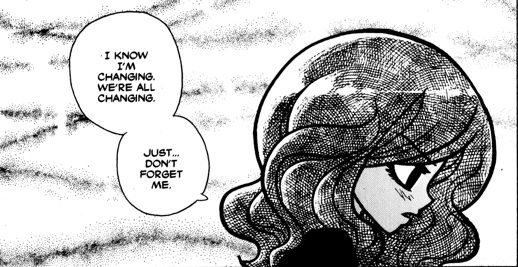 So
it’s hard to consider his point of view to be objective when it comes
to Envy. In the sixth volume, Envy says as much: “You make me out to be
some kind of villainess. We were practically kids when we dated, Scott, and it’s not like you
were some paragon of virtue.” She claims that Scott broke her heart,
just as she broke his, and reminds him that he was the one who started
that final argument. Scott needed not to be the bad guy in their
relationship, so he made Envy suit the role.
The
concept of perception is further complicated by a statement Envy makes
at the end of this conversation: “I know I’m changing. We’re all
changing. Just... don’t forget me. This is the only me he
knows...” This is an issue that goes beyond the problematic aspects of
Scott’s suffocating perception that we brought up in our discussion of
Kim. Guilty of papering over real events with his more convenient
memories, Scott is being entrusted with the preservation of Natalie V.
Adams. He must keep an entire person alive.
So
it’s hard to consider his point of view to be objective when it comes
to Envy. In the sixth volume, Envy says as much: “You make me out to be
some kind of villainess. We were practically kids when we dated, Scott, and it’s not like you
were some paragon of virtue.” She claims that Scott broke her heart,
just as she broke his, and reminds him that he was the one who started
that final argument. Scott needed not to be the bad guy in their
relationship, so he made Envy suit the role.
The
concept of perception is further complicated by a statement Envy makes
at the end of this conversation: “I know I’m changing. We’re all
changing. Just... don’t forget me. This is the only me he
knows...” This is an issue that goes beyond the problematic aspects of
Scott’s suffocating perception that we brought up in our discussion of
Kim. Guilty of papering over real events with his more convenient
memories, Scott is being entrusted with the preservation of Natalie V.
Adams. He must keep an entire person alive.
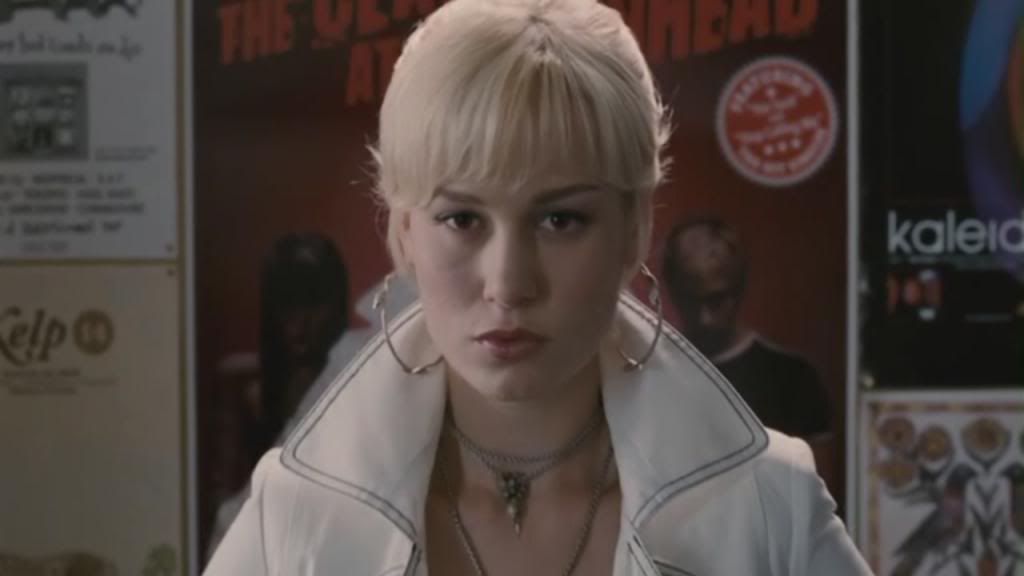 What
troubles us -- and what we’re pretty sure is supposed to trouble us --
about this line is the way it frames and genders memory. Scott’s story
involves him having to look beyond his own straight, white, male
narrative in order to acknowledge the truth of other viewpoints. What
are the implications, then, of Envy entrusting him with her self before
he has seen the error of his ways? Indeed, what are the implications of
allowing a woman’s identity to be maintained or determined by a man? In
addition, it’s problematic not only that Scott is made responsible for
Natalie, but that Gideon is seemingly creating Envy. Scott is therefore
protecting her past self from Gideon’s controlling influence. Unlike
Ramona, who finds a way to save herself using an army of Ramonas, Envy
is defined by men.It
almost seems disingenuous to mention the film version here, because
she’s nothing more than a caricature. She doesn’t even get to fight. She
does, however, get to rock a Metric song.Verdict: Love Interest
What
troubles us -- and what we’re pretty sure is supposed to trouble us --
about this line is the way it frames and genders memory. Scott’s story
involves him having to look beyond his own straight, white, male
narrative in order to acknowledge the truth of other viewpoints. What
are the implications, then, of Envy entrusting him with her self before
he has seen the error of his ways? Indeed, what are the implications of
allowing a woman’s identity to be maintained or determined by a man? In
addition, it’s problematic not only that Scott is made responsible for
Natalie, but that Gideon is seemingly creating Envy. Scott is therefore
protecting her past self from Gideon’s controlling influence. Unlike
Ramona, who finds a way to save herself using an army of Ramonas, Envy
is defined by men.It
almost seems disingenuous to mention the film version here, because
she’s nothing more than a caricature. She doesn’t even get to fight. She
does, however, get to rock a Metric song.Verdict: Love Interest
Roxie Richter
If
we’re discussing the ex who most influenced Scott, we have to talk
about the ex who, aside from Gideon, had the greatest influence on
Ramona.
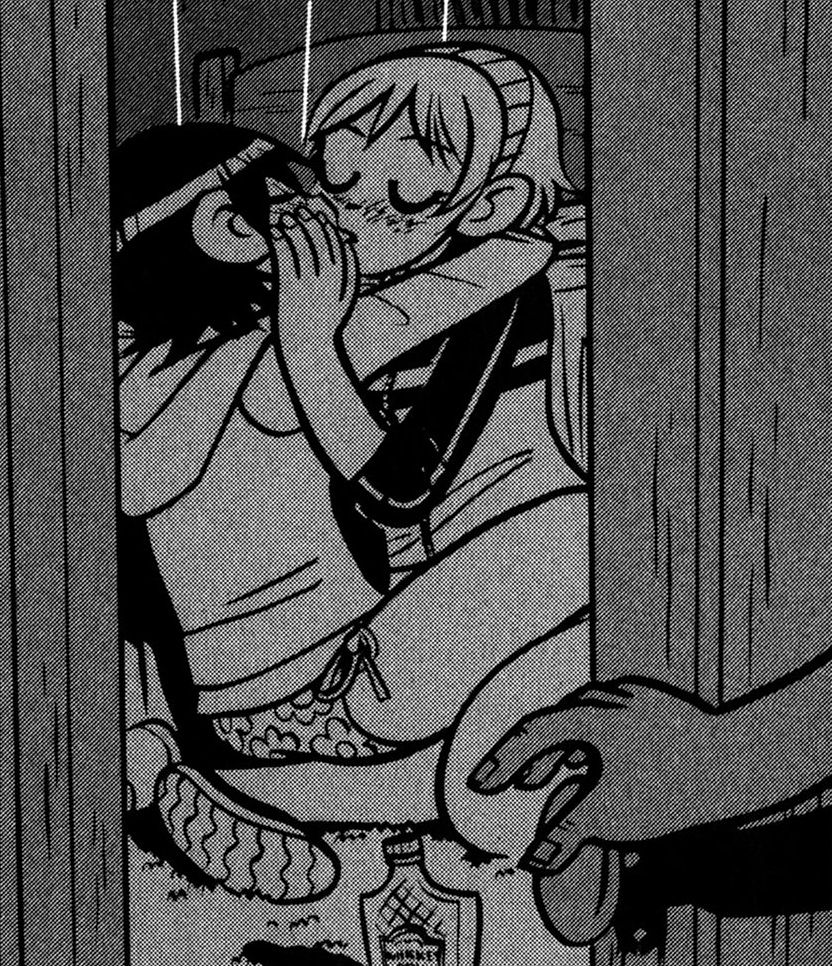 Roxie Richter affects the story even before she is introduced. In the world of Scott Pilgrim,
male homosexuality has always existed, in the form of Wallace Wells,
his boyfriend, Mobile, the Other Scott, Kim’s roommate, Joseph, and, at
the last possible second, Stephen Stills. Queer female sexuality,
however, doesn’t warrant a mention until the fourth volume, when it is
suddenly EVERYWHERE. Kim and Knives have a drunken make-out session, and
Ramona starts to make comments about marrying Kim. Wallace tells Scott
to break out the “L” word, to which Scott responds, “Lesbian?” It seems
almost as if O’Malley thought he needed to remind his readers that women
can be interested in other women so we wouldn’t be shocked when an
actual queer woman showed up.Roxie
is introduced as an almost invisible force, which seems somehow
appropriate when she represents a group of people heretofore invisible
in the series’ universe. We learn that the canonical reason for this is
that she is a half-ninja and therefore has a sword, as well as the
ability to move with “almost ninja-like stealth and speed.” We also
learn that Roxie and Ramona were roommates at the University of Carolina
in the Sky, a floating school tethered to a mountain by a giant chain.
Unlike any ex before her, Roxie seems to have Ramona’s number, calling
her out on her habitual cheating. At the same time, Roxie is clearly the
ex Ramona knows best, evidenced by the familiarity of their highly
personal insults.There
is a strange and unpleasant subtext in the treatment and
characterization of Roxie. She is intensely insecure, interpreting
Ramona’s comment that she’s a lousy excuse for a ninja as a slight
against her half-ninja status: “Half ain’t good enough, huh?!” When
Knives’ father shows up to fight Scott, Roxie immediately assumes that
Gideon sent him to help her. She has an emotional outburst, shouting, “I
don’t need help! Why doesn’t anyone ever believe
in me?!” Even the expository text doesn’t respect her, identifying her
as the “4th evil ex-boyfriend.” Further supporting the idea that no one
takes her seriously is the fact that, after Scott avoids every
opportunity to fight her, one time even going so far as to hide in
Ramona’s subspace suitcase, he defeats her with a single blow.It
seems to be no coincidence that she is the ex that represents a
homosexual blip in Ramona’s largely heterosexual dating history. Her
relationship with Ramona was, for Ramona, apparently just a phase. Even
when Roxie promises to kill him, Scott doesn’t consider the possibility
that she might be one of the evil exes or, indeed, the reason why Ramona
no longer refers to them as her seven evil ex-boyfriends. Instead, he
assumes that Roxie is merely dating one of the exes. The realization of
her true identity is so momentous that it requires an entire page for
Scott’s brain to literally crack open. He points a finger, almost in
accusation, and then, when Ramona says that it was only a phase, he
replies, “You had a sexy phase?!” Every other ex at this level is a serious threat, and Roxie is part of a sexy phase.
Indeed,
the book even puts forward the idea that a woman cheating on a man with
another woman isn’t actually cheating. When Ramona tries to apologize
to Scott for Roxie staying at her place, she assures him that they
“didn’t even make out that much.” This is apparently not infidelity
enough to get in the way of an exchange of love confessions.To
add insult to injury, Roxie shows up in the volume where Scott finally
gets up the nerve to tell Ramona that he loves her, thereby earning a
sword representing the Power of Love. So the heterosexual man defeats
the queer woman who dated his girlfriend with the power of heterosexual
love. This may be the absolute worst statement made in the entirety of
the series.
It’s
especially obvious that Roxie and Ramona’s relationship is invalidated
due to Roxie’s gender, as she is actually quite clearly second only to
Gideon in the extent of her effect on Ramona. Ramona’s trademark
rollerblades seem to be a riff on Roxie’s rollerskates. Roxie claims on
two occasions to have taught Ramona everything she knows about subspace.
She seems to be the only person Ramona didn’t just play with for a few
days or weeks before she got tired of them, as demonstrated by their
familiarity with each other and Ramona’s decisions to have lunch with
Roxie and visit her gallery opening.What
complicates the portrayal of Roxie in the comic is, as always, the fact
that we are still by the fourth volume quite firmly entrenched in
Scott’s point of view. His heteronormative viewpoint may be affecting
the storytelling itself. This seems unlikely, however, because most of
the instances where Scott’s perspective has a profound effect are
interrogated in some way. This is played pretty straight. (Pun
intended.)What
is also played pretty straight is the film’s rendition of the Scott vs.
Roxie battle. We’ve talked in every post in this series about the
injustices done to the female characters in their translation from page
to screen. In a lot of ways, it may have been more apt to call this
series “Scott Pilgrim Vs. the World Vs. the Girls.” Still, no female character’s arc becomes more thoroughly offensive than Roxie’s.Roxie,
or Roxy, as she’s apparently called in the film, is introduced almost
exactly as she is in the comic. Her defeat, however, could not be more
different. This is partially because in the original, it’s not actually
her battle, but rather one that takes place between Ramona and Envy. The
battle begins when an invisible Roxy punches Scott in the back of the
head and knocks him to the ground. As he sits up, we’re given a
delightful view of him framed by Roxy’s legs, just to demolish any hope
you may have had that Roxy was going to be treated as seriously as the
other exes.This
becomes even clearer when Ramona tells Scott not only that her
relationship with Roxy was a phase, but that “it meant nothing. I didn’t
think it would count! … I was just a little bicurious.” As if this
weren’t bad enough, the soundtrack for the reveal that Roxy is one of
the evil exes is punctuated with breathy feminine sighs.
Roxie Richter affects the story even before she is introduced. In the world of Scott Pilgrim,
male homosexuality has always existed, in the form of Wallace Wells,
his boyfriend, Mobile, the Other Scott, Kim’s roommate, Joseph, and, at
the last possible second, Stephen Stills. Queer female sexuality,
however, doesn’t warrant a mention until the fourth volume, when it is
suddenly EVERYWHERE. Kim and Knives have a drunken make-out session, and
Ramona starts to make comments about marrying Kim. Wallace tells Scott
to break out the “L” word, to which Scott responds, “Lesbian?” It seems
almost as if O’Malley thought he needed to remind his readers that women
can be interested in other women so we wouldn’t be shocked when an
actual queer woman showed up.Roxie
is introduced as an almost invisible force, which seems somehow
appropriate when she represents a group of people heretofore invisible
in the series’ universe. We learn that the canonical reason for this is
that she is a half-ninja and therefore has a sword, as well as the
ability to move with “almost ninja-like stealth and speed.” We also
learn that Roxie and Ramona were roommates at the University of Carolina
in the Sky, a floating school tethered to a mountain by a giant chain.
Unlike any ex before her, Roxie seems to have Ramona’s number, calling
her out on her habitual cheating. At the same time, Roxie is clearly the
ex Ramona knows best, evidenced by the familiarity of their highly
personal insults.There
is a strange and unpleasant subtext in the treatment and
characterization of Roxie. She is intensely insecure, interpreting
Ramona’s comment that she’s a lousy excuse for a ninja as a slight
against her half-ninja status: “Half ain’t good enough, huh?!” When
Knives’ father shows up to fight Scott, Roxie immediately assumes that
Gideon sent him to help her. She has an emotional outburst, shouting, “I
don’t need help! Why doesn’t anyone ever believe
in me?!” Even the expository text doesn’t respect her, identifying her
as the “4th evil ex-boyfriend.” Further supporting the idea that no one
takes her seriously is the fact that, after Scott avoids every
opportunity to fight her, one time even going so far as to hide in
Ramona’s subspace suitcase, he defeats her with a single blow.It
seems to be no coincidence that she is the ex that represents a
homosexual blip in Ramona’s largely heterosexual dating history. Her
relationship with Ramona was, for Ramona, apparently just a phase. Even
when Roxie promises to kill him, Scott doesn’t consider the possibility
that she might be one of the evil exes or, indeed, the reason why Ramona
no longer refers to them as her seven evil ex-boyfriends. Instead, he
assumes that Roxie is merely dating one of the exes. The realization of
her true identity is so momentous that it requires an entire page for
Scott’s brain to literally crack open. He points a finger, almost in
accusation, and then, when Ramona says that it was only a phase, he
replies, “You had a sexy phase?!” Every other ex at this level is a serious threat, and Roxie is part of a sexy phase.
Indeed,
the book even puts forward the idea that a woman cheating on a man with
another woman isn’t actually cheating. When Ramona tries to apologize
to Scott for Roxie staying at her place, she assures him that they
“didn’t even make out that much.” This is apparently not infidelity
enough to get in the way of an exchange of love confessions.To
add insult to injury, Roxie shows up in the volume where Scott finally
gets up the nerve to tell Ramona that he loves her, thereby earning a
sword representing the Power of Love. So the heterosexual man defeats
the queer woman who dated his girlfriend with the power of heterosexual
love. This may be the absolute worst statement made in the entirety of
the series.
It’s
especially obvious that Roxie and Ramona’s relationship is invalidated
due to Roxie’s gender, as she is actually quite clearly second only to
Gideon in the extent of her effect on Ramona. Ramona’s trademark
rollerblades seem to be a riff on Roxie’s rollerskates. Roxie claims on
two occasions to have taught Ramona everything she knows about subspace.
She seems to be the only person Ramona didn’t just play with for a few
days or weeks before she got tired of them, as demonstrated by their
familiarity with each other and Ramona’s decisions to have lunch with
Roxie and visit her gallery opening.What
complicates the portrayal of Roxie in the comic is, as always, the fact
that we are still by the fourth volume quite firmly entrenched in
Scott’s point of view. His heteronormative viewpoint may be affecting
the storytelling itself. This seems unlikely, however, because most of
the instances where Scott’s perspective has a profound effect are
interrogated in some way. This is played pretty straight. (Pun
intended.)What
is also played pretty straight is the film’s rendition of the Scott vs.
Roxie battle. We’ve talked in every post in this series about the
injustices done to the female characters in their translation from page
to screen. In a lot of ways, it may have been more apt to call this
series “Scott Pilgrim Vs. the World Vs. the Girls.” Still, no female character’s arc becomes more thoroughly offensive than Roxie’s.Roxie,
or Roxy, as she’s apparently called in the film, is introduced almost
exactly as she is in the comic. Her defeat, however, could not be more
different. This is partially because in the original, it’s not actually
her battle, but rather one that takes place between Ramona and Envy. The
battle begins when an invisible Roxy punches Scott in the back of the
head and knocks him to the ground. As he sits up, we’re given a
delightful view of him framed by Roxy’s legs, just to demolish any hope
you may have had that Roxy was going to be treated as seriously as the
other exes.This
becomes even clearer when Ramona tells Scott not only that her
relationship with Roxy was a phase, but that “it meant nothing. I didn’t
think it would count! … I was just a little bicurious.” As if this
weren’t bad enough, the soundtrack for the reveal that Roxy is one of
the evil exes is punctuated with breathy feminine sighs.
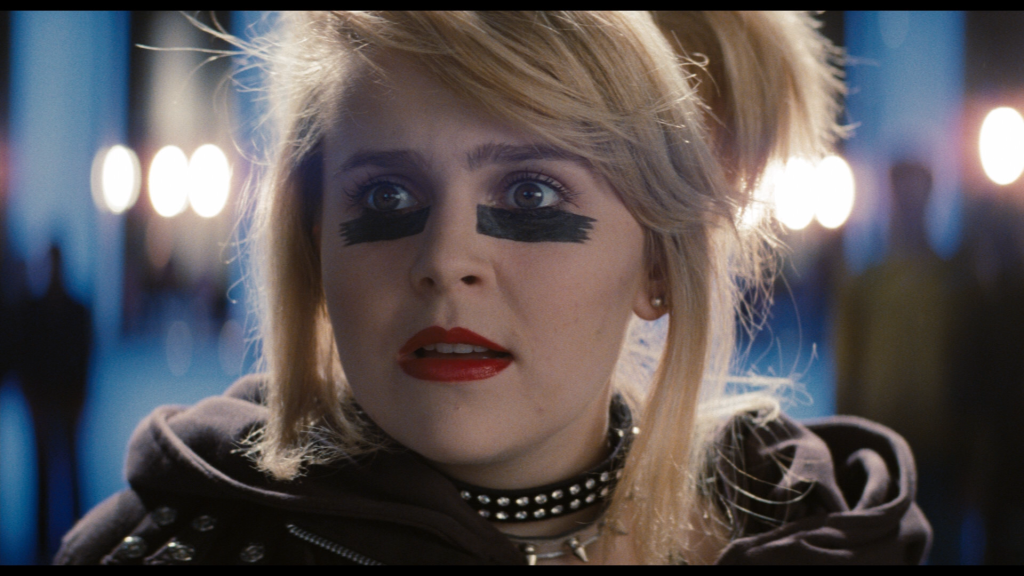
When
Roxy then tries to attack Scott, Ramona intervenes; in this version,
she doesn’t fight Roxy because Scott is hiding behind the rules of
chivalry and his own terror, but because she just... does? It’s not
explained. Roxy also suddenly fights with a whip-sword-belt-thing
because, I don’t know, it’s sexier than a sword or something. (The
change is likely a matter of increasing visual interest and avoiding
repetition in a film where the final battle involves swords, but
still...) When Roxy reveals that Scott will have to defeat her by his
own hand, he protests, saying that he can’t hit a girl. Instead of
denying Scott the moral high ground he thinks he deserves for taking
this position, as Ramona and Roxie both do in the book, Ramona just
tells him that he has no choice... and then proceeds to control his
limbs as he enters into fisticuffs with Roxy. Then
something happens that makes us a little bi-furious. As Roxy lifts her
leg in the air to deliver the final blow, Ramona tells Scott that Roxy’s
weakness is an erogenous zone at the back of her knee. This will be
familiar to readers of the comic as Envy’s weakness, discovered by Scott
during a serious two-year relationship, and used to take her down in a
non-lethal manner. In the movie, however, it is a weakness discovered
during just-for-fun make-out sessions, used by a straight man to orgasm a
queer woman to death. Roxy’s last words: “You’ll never be able to do
this to her,” followed by a blissful moan. Our reaction: not suitable
for print.What
really irks us about this scene is that it is so intentional. Roxy
suffers a perfectly adequate, if still dubious, defeat in the comic, so
the appropriation of Envy’s fight and weakness represents a deliberate
change. A character that is already treated as a joke is humiliated in
an incredibly offensive way, and we’re supposed to find it funny. We
are, perhaps, even supposed to think it better than the original. We’re
actually not sure what could have been worse.Verdict: Love Interest (Comic) and NO NO NO OH GOD WHY (Film)
KNIVES CHAU17 YEARS OLDSTATUS: TOTALLY CRAZY
“Scott
Pilgrim is dating a high schooler!” So begins the tale of Scott
Pilgrim, introducing at the same moment its titular character and his
seventeen-year-old counterpart, Knives Chau.Knives
enters the story as a stereotypical Asian teenager, complete with
overbearing parents and advanced textbooks. She initially treats Scott
as another friend, regaling him with stories of high school drama. Their
relationship is almost preternaturally innocent, and it is only after
she hears Sex Bob-omb play for the first time that her obsession with
Scott truly takes hold. Hearing those poorly played chords pitches her
face first onto the Yellow Brick Road to adulthood; though her world as
we see it remains a land of black and white, she has clearly had her
first glimpse of Technicolor.For
Kim, music is a constant, structuring her life; for Knives, it is a
gateway to emotions and situations she has never before had a chance to
experience. When Scott starts dating Ramona, Knives bemoans her relative
lack of life experience: “She’s had time, you know?? She’s got a head
start! What am I supposed to do?? How do I fight that? I didn’t even
know there was
good music until like two months ago!!” Knives frames what she seems to
think of as a kind of life seniority in terms of music knowledge, as if
everyone had an equally melodic moment of maturation. Her
discovery of music also coincides with the beginning of her search for a
model of femininity to emulate. After that first rehearsal, she cuts
her hair and starts to dress like Kim. Once Scott has dumped her for
Ramona, she gets highlights, mimicking Ramona’s dye job as if that will
restore her to Scott’s favour. Although she doesn’t imitate any
particular aspect of Envy’s style, she does become obsessed with her,
not only explicitly calling her her role model, but also freaking out
over the idea that she’s kissed the lips that have kissed Envy. She even
tells Scott that he’ll “always be [her] Clash at Demonhead,”
compounding in one sentence her love of Scott, her obsession with Envy,
and her devotion to music.This
is not to say that Knives’ attitude toward other women is at all
positive or healthy. For the majority of the series, she views Ramona as
the harlot who stole her man while refusing to see Scott for the cad he
demonstrably is. She is constantly using gender-based insults like
“slut” and often stoops to calling other women “ugly” or “fat,”
regardless of evidence for either claim. Accordingly,
most of Knives’ characterization revolves around her being herself a
kind of two-dimensionally awful woman. She is the Crazy Ex-Girlfriend
who becomes a stalker and picks fights with her ex’s current love
interest, asserting throughout that she’s a “Scottaholic.” She dates
Young Neil because he looks like Scott. She even has a shrine. In a
narrative that revolves around Scott, she becomes proof of the damage a
Scott-centred existence can do.
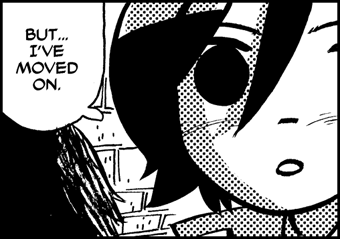
She
is also, in many ways, a reflection of Scott. His dating her represents
a regression, as he turns to the easy world of teenage dating to avoid
the realities of adulthood. Over the course of the series, he must grow
up and learn to take responsibility for his own actions, learning that
life isn’t a video game, even if he appears to be living in one. Knives
undergoes a more straightforward, if less thoroughly explored,
coming-of-age story. She is introduced as a shy, naive child who begins a
musically triggered metaphorical puberty. By the third volume, she is
beginning to understand the double-edged sword that is adulthood: “I
mean, I’m not totally happy, but there’s no way I’d go back to my old
oblivious self! I like it here. I like all the... confusion and
heart-break. … I feel like I’ve learned some stuff along the way. I know
things now.” Eventually, by the final book, Knives’ development has
surpassed Scott’s. She is eighteen, an adult in the eyes of the law and a
soon-to-be graduate of high school, and she has left the stalled Scott
behind. This becomes obvious when she rejects Scott’s offer of casual
sex, telling him that they should try to be grown-ups.Her
maturity is finally demonstrated by her decision to let Scott go. He
retains the importance of being her first boyfriend as well as the
person who helped open her eyes to the world beyond her Catholic school,
but that’s all. As she asserts, “I’m happy being alone right now,
Scott. I’m trying to learn to like me. Alone.” Best ending for a character that seemed to be nothing more than a caricature of a crazy ex? We think so.
The
film’s version of Knives doesn’t fare much better than Ramona or Kim.
While she does get to replace Ramona in the final battle against Gideon,
she was only there because she wanted to fight Ramona and punish her
for stealing Scott. Whereas the comic leaves us with an image of Knives
as an independent person striking out on her own, the film ends with
Knives telling Scott to go get the girl, assuring him with a wry “I’m
too cool for you anyway.” It’s an important and disappointing
difference. Comic!Knives completes her character arc by growing up, and
leaving Scott behind is merely part of the process. Movie!Knives
completes her own arc by letting Scott go, making the romantic
relationship the whole point of her story. As you may imagine, we don’t
like this ending very much at all.Verdict: Supporting Role (Comic) and Love Interest (Film)
In the marketing for the film, Scott Pilgrim vs. The World,
Kim Pine is described as “the sarcastic one.” The movie’s two-hour
runtime demanded an all-encompassing simplification of the story from
which few characters escaped unscathed. The greatest casualty aside from
Ramona, Kim retains -- but is also ultimately reduced to -- her quick,
acerbic wit. The Kim of the film is not the Kim of the comic, but rather
the self that Comic!Kim wishes the world to see.At
first glance, Kim is a simple character: she hates everything. In fact,
she is almost relentlessly pessimistic. She never misses a chance to
talk about how much Sex Bob-omb sucks. She leaps at every opportunity to
criticize Scott. She despises everyone, including her friends.
Except,
of course, that she doesn’t. She loves music, evidenced by the
flashback in which she pauses in the middle of a back seat session with
Scott to get him to listen to the song on the radio. Although she acts
like Sex Bob-omb’s rehearsals and gigs are the worst part of her day,
she later confesses that they give her life structure and, at the end of
the series, we see that she has joined Scott’s new group, Shatterband.
Keeping time behind a drum set seems to give her some kind of control,
real or imagined, over what is revealed to be a pretty dismal existence.In
a conversation with her boss, Hollie, Kim tells her that she hates her.
“You hate everyone, Kim,” Hollie observes, prompting Kim to reply,
“You’re one of everyone.” Although this exchange is clearly intended to
be funny, there is more than a little truth to the statement, and more
than a little justification for Kim’s misanthropy. Most of the people in
her life really do suck. While Scott is too busy fighting exes to
direct our attention to her, Kim suffers a number of personal blows. She
deals with the roommates from Hell (whose antics are briefly chronicled
in a separate one-shot entitled, as ironically as humanly possible,
“The Wonderful World of Kim Pine”), before moving in with Hollie. Hollie
promptly sleeps with Kim’s boyfriend, thereby turning her home --
already the site of the recording that has disrupted the steady rhythm
of her life -- into a hostile territory. It’s not difficult to see how
Kim could claim to hate everyone.“Everyone,”
however, has some notable exceptions, among them one Ramona Flowers.
Ramona and Kim forge a friendship based on their mutual disdain for
idiocy as well as a genuine appreciation for each other. They banter
easily, but Kim knows when to give Ramona her space. The best example
occurs when Kim notices Ramona’s head glowing and decides to gather
photographic evidence in order to confront her about it. When Ramona
gets defensive, Kim backs off, saying, “If you can’t tell me, you can’t
tell me. I won’t be offended.” She tries to make Ramona see that there
is a problem, but doesn’t force her to deal with it. In a series with
numerous girl vs. girl verbal and physical smackdowns, such a friendship
is refreshing. Kim’s ability to handle Ramona also clarifies the nature
of her misanthropy: she dislikes people not because she doesn’t
understand them, but because she so clearly does, which may be the
reason why she always expects them to let her down.And
let her down they do, perhaps no one more than Scott. In the fifth
volume, while in the process of kidnapping her, the Katayanagi twins
observe that she has “been there all along,” standing beside Scott.
While she does insult him, she also encourages him; for every few digs
along the lines of “Scott, if your life had a face, I would punch it. I
would punch your life in the face,” there’s a “Come ON, Scott! You can
do this, you know. You’re not as clueless an idiot as you seem!”
Unfortunately, Scott does not offer the same support in return.
The
altercation with the Katayanagis is a defining moment for Kim, as she
is confronted with the reality of her one-sided relationship with Scott.
Still, even when she cannot convince Scott to save her for her own
sake, she helps him to defeat the twins by pretending that her
inspirational words are Ramona’s. In a way, by manipulating Scott, she
saves herself. As Kim departs at the end of the book, Scott apologizes
for everything. When Kim dismisses it, telling him it’s not his fault,
he shouts, “Sorry about me!” This is the apology that Kim can accept. Kim’s importance to Scott Pilgrim as a character is reflective of her importance to Scott Pilgrim
as a series. If Scott is the lens through which the story is told, and
Ramona is its focal point, Kim Pine is the person standing next to you,
pointing to the lens and saying, “Trust nothing it shows you.”
Throughout the series, Kim serves as a kind of bullshit detector, as she
uses her substantial powers of observation to interrogate Scott’s
version of events. She questions his decision to date a high schooler,
his validity as a hero, and, ultimately, the reliability of his
narration. Multiple characters point out the holes in Scott’s
recollections, but Kim is the person who breaks him out of his cycle of
forgetting and forces him to restore the memory of his mistakes. Her own
story literally replaces the one we already read, panels from earlier
volumes juxtaposed with new versions in a displacement of fiction by
fact. Kim is the person responsible for dismantling Scott’s subjective
narrative.
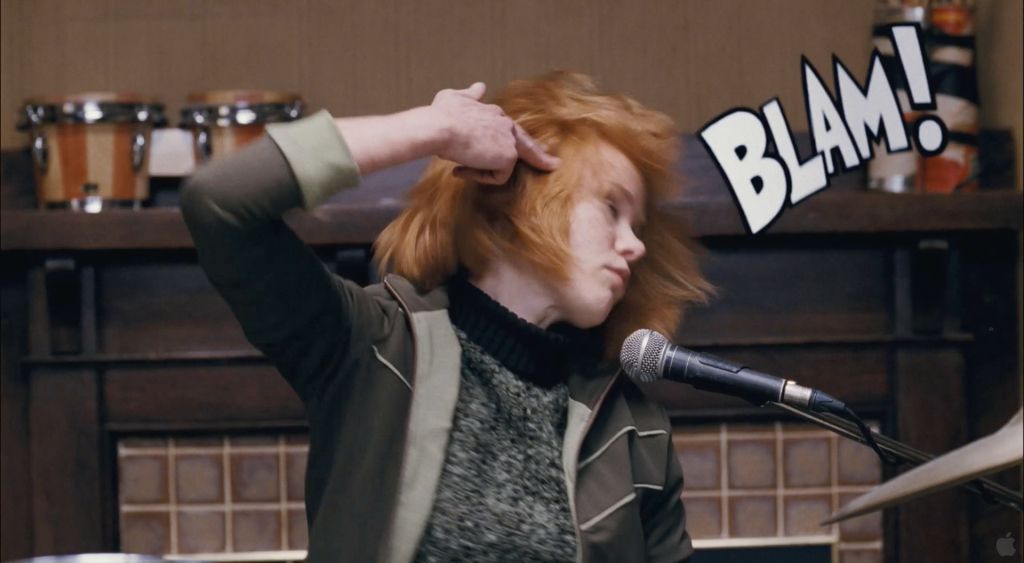
This
is why her diminished presence in the film is such a crime. The
viewer’s perception is even more closely tied to Scott’s point of view,
which is worrying on a metatextual level. In the film, the dominant
narrative isn’t questioned, whereas, in the books, the convenient lies
Scott tells himself are replaced by the truth as witnessed by those he
wronged. The film eliminates so many of the book’s more compelling ideas
about the importance of perception in storytelling. For this reason, we
would have preferred it if the girl who has “been there all along” had
actually been there in her entirety.It’s
difficult to determine where Kim falls on our scale of character
strength. She is a past love interest, as well as a supporting character
in every sense of the word. She has her own life, but we are largely
denied access to it. The life we do see technically revolves around a
man, but she has clearly decided to make a change in that respect. We’re
inclined to say that she falls somewhere between the categories of
Strong Female Character ™ and Actual Strong Female Character, but we’re
certainly open to other interpretations.Verdict: Actual Strong Female Character ™
RAMONA FLOWERS
AMERICAN NINJA DELIVERY GIRL
AGE UNKNOWN
EVERYTHING UNKNOWN
FUN FACT: UNKNOWN
Ramona
Flowers is American. Ramona Flowers is the girl of Scott Pilgrim’s
dreams, literally. Ramona Flowers is a mystery, wrapped in an enigma,
wrapped in a conundrum, all surrounding a squishy, straightforward
centre: a Tootsie Roll Pop of characterization. And if Scott Pilgrim is
the lens through which the story is told, Ramona Flowers is its focal
point.
When
she first enters the story, rollerblading across an arid desert of
loneliness, Ramona seems like she will be no more than one more in a
long line of Manic Pixie Dream Girl characters. The MPDG is a term
coined in 2005 to describe a young, spirited woman who is so high on
life that she must drag the male protagonist along for the ride, turning
his boring life upside down and giving him the motivation he previously
lacked.
Like
many a Manic Pixie Dream Girl, Ramona is introduced as the solution to
the male protagonist’s dull, static existence. She is quirky,
intelligent, and ever-changing. Unlike the typical MPDG, however, Ramona
clearly has an existence outside the protagonist’s limited world. Her
mysterious allure is less the result of a personality tailored to the
needs of the hero than a simple matter of the hero not taking an
interest in learning about her. The MPDG trope is brutally taken to
account when Scott and Ramona have a discussion about what attracts each
of them to the other. Scott claims to like Ramona because she is
mysterious, and Ramona quite understandably thinks that that’s not
enough and that he should know more about her like, say, her age. When
he replies that it’s unknown, as if that’s a valid excuse, she responds
by saying that he could just ask. In this moment, Ramona introduces the
idea that she is not a mystery forever resisting a solution, but an
actual person with whom Scott could interact on a human level.
Because
the series is so thoroughly based in Scott’s subjective viewpoint, it
makes sense that the reader comes to know Ramona just as Scott does. In
the first volume, Ramona is introduced as a prize, and objects have no
need of a personality. In order to win her, Scott must defeat her seven
evil exes in a series of increasingly difficult boss battles. What is
particularly interesting is that Matthew Patel, the first evil ex,
emails Scott before Ramona has expressed any interest in him; he begins
the path toward winning Ramona even before she has consented to being
won.
One
of the great accomplishments of the series lies, then, in the paradigm
shift from viewing a woman as an object to be won to accepting her as a
whole person with agency and subjectivity; this is the development from
apparent Manic Pixie Dream Girl to Actual Strong Female Character.
Ramona is not perky, upbeat, or fun-loving; rather, she is sarcastic and
brutally honest, encouraging Scott to grow up and take responsibility
for himself instead of luring him out into the world through the sheer
force of her frenetic energy. Despite her use of subspace travel, she is
not some sort of otherworldly being. In fact, the text goes to great
lengths to point out similarities between Scott and Ramona, from their
propensity for cheating to their selfishness to their decision to take
wilderness sabbaticals following their break-up. Just as Scott turned to
video games to escape from his problems, Ramona, who had intended to
work through her own issues, “just ended up sleeping all day, dicking
around on the Internet and watching every episode of The X-Files.” In that moment, she may have become the most relatable character in the series.
Although
she resembles Scott in certain ways, she exists outside of him. Like
Princess Kida, it seems like we meet Ramona part way through her own
story: a comic already in progress that just happens to crossover with
the one that we’re reading. She has an extensive backstory involving her
seven evil exes (and at least one non-evil one) delivered in
intriguing, if sometimes frustratingly brief, snippets. She also has her
own friendship with Kim, based on their mutual hatred of idiocy. By the
third volume, Ramona turns the quest narrative on its head by taking
her own shot at defeating an evil ex: Scott’s former girlfriend Envy
Adams. At this point, Scott temporarily becomes a prize. Ramona further
subverts the narrative by fighting Roxie, her fourth ex, in a sense
fighting the battle for her self (and shooting for her own hand).
In
the fifth volume, Ramona gains some autonomy from Scott’s point of
view, achieving a kind of temporary subjectivity. She has a series of
introspective moments, the most revealing of which occurs, conveniently,
as she tries on clothing while shopping. In the two-page scene, she is
clearly dissatisfied with herself; no outfit seems to work, so she tries
to adjust her hair, and finally takes refuge in her hood. Throughout
the scene, we see both her and her reflection but, while at first we
mainly see her, as the scene goes on, we see more and more of the
reflection and less and less of the person. The fact that Ramona
ultimately decides to hide her hair -- her most distinctive feature --
is telling. Bryan Lee O’Malley has stated on his blog that Ramona
changes her hair to try on different identities, depending on the
emotional state that she is in. Covering it, then, suggests that she
cannot face any version of herself.
This
finally changes in the final book. The sixth volume marks the moment
when Scott comes into his own as a person aware of other people;
accordingly, it also contains Ramona’s crowning moments of character
development. After a long absence, Ramona re-enters the story at the end
of all things... or, at least, the end of Scott. This entrance directly
echoes her first one, but this is definitely not the same Ramona. She
observes in a candid moment, “Yes, I’m selfish. I’ve dabbled in being a
bitch. But listen... I came back because... because I’m always the one
who leaves. I could never say goodbye. I don’t want to be that person
anymore. So... I’m sorry, Scott. I came back to say I’m really really
sorry.” She does come back for herself, but explicitly in order to make a
better version of herself.
In
a series that revolves around the battle for Ramona, the best moments
occur when she takes an active role in the fight. In this final
showdown, we learn that Ramona has made a habit of beating Gideon at his
own game. The bizarre glow that allowed her to disappear was originally
invented as a form of imprisonment; Gideon states that it “seals you
inside your head. Just you and your issues. And once you’re hit, that’s
it. No cure. It’s chronic. … But this brilliant self-hater, she found a
way to turn it to her advantage...” Ramona transforms these mental
shackles into a form of liberation, using the glow as a way to access
subspace.
When
she is imprisoned in the all too literal -- if technically figurative
-- shackles Gideon forces her to wear in her head, Ramona frees herself,
telling Gideon, “You know, you’re right. Part of me does still belong
to you. But the other parts of me... are finished
with you!” A league entirely comprised of versions of Ramona that we
have seen throughout the series appears to back her up as she banishes
Gideon from her head, forever answering the question, “You and what
army?” As if that weren’t enough, she then blocks the blow that would
kill Scott using her subspace suitcase, literally and figuratively
shedding her baggage. Finally, she gains the Power of Love, just as
Scott did in Volume 4, and teams up with him to take down Gideon with
simultaneous slices. Ramona is just as much a hero as Scott.
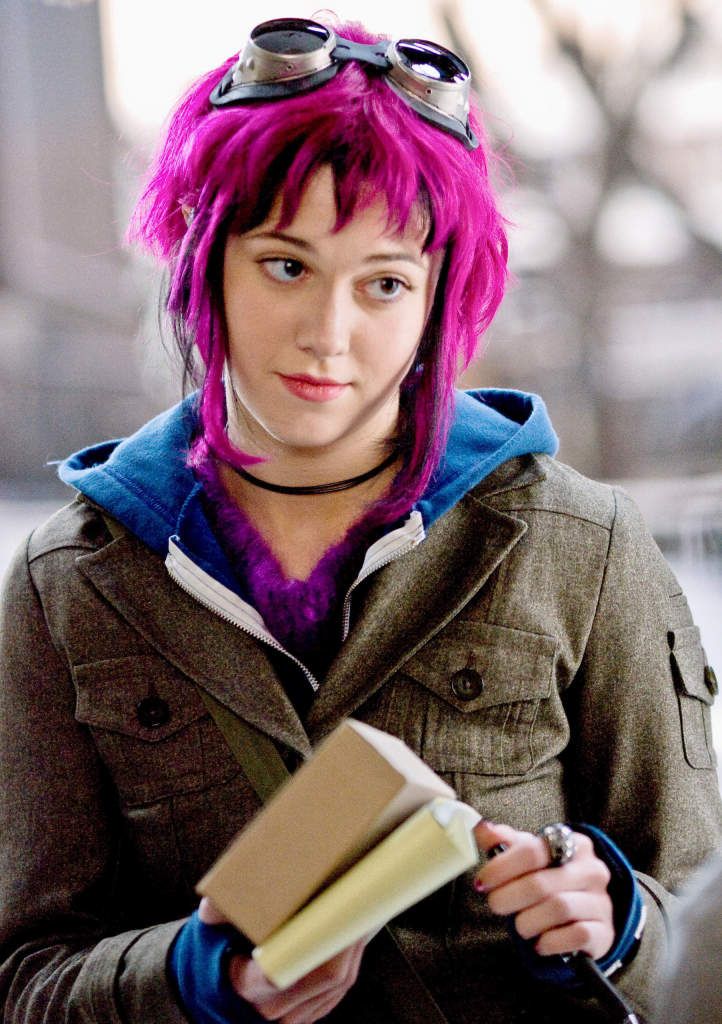
Unfortunately,
the same cannot be said of the film version. Changes must be made when
adapting six books into one movie, but it’s still unfortunate that
Ramona’s characterization loses so much in the translation. Movie Ramona
is a far more straightforward Manic Pixie Dream Girl. She goes back to
Gideon because she “can’t help [her]self around him.” He has a way of
getting into her head, and that way is a microchip, apparently. (Neither
its presence nor its shutdown is really explained.) She steals Envy’s
shining moment, kicks Gideon in the groin, takes a beating for her
troubles, and then spends the final battle looking on as Knives teams up
with Scott to beat Gideon. Knives encapsulates all the problems with
this version in one line: “You’ve been fighting for her all along.”
The
Ramona of the comic fights for herself. There’s a big difference
between being a sprite on a screen and the person playing the game, and
we’ll always side with the woman holding the controller.
Verdict: Actual Strong Female Character (comic) and Love Interest (film)

